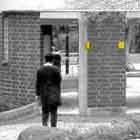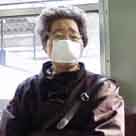|
[s1]
home
prototypes
action
plan
database
|
|
scenario
game |
|
| |
animator:
Yusaku Imamura
|
player
Erasure:
Yu-Sun Ko [erasure
psychology] |
|
|
action
plan [a1] |
player
Origination:
Jonas Upton-Hansen
[P-17] |
|
|
actors/agents |
player
Transformation:
Koen Klinkers
[linear cities] |
|
|
operational
fields |
player
Migration:
Pato Hayashi [p11] |
|
|
prototype |
| |
|
|
web
site links |
| 1E |
The public toilet has no doors .
|
 |
| 1O |
A
man inside the toilet becomes aware of being watched. |
|
| 1T |
He
adjusts his posture to prevent himself from being seen.
|
|
| 1 M |
He leaves quickly through the
exit on the other side. |
|
|
|
|
| 2 E |
No
one uses the public toilet anymore. |
|
| 2
O |
Bun-Kyo-Ku
ward Park & Greens Department has to find new ways to deal with toilets.
(several complaints were received from users and local residents) |
|
| 2
T |
The
park becomes one big toilet.
(people starts using the park to dispose of their waste, making the park
dirty and unhygenic) |
this
kind of condition already exists in Tokyo. Tokyo drunk salary-men use electric
poles as WC. |
| 2
M |
Normal
park users migrate to other places. |
 |
| |
|
|
| 3
E |
Homeless
people are erased from the streets.
(as they start migrating into the park) |
|
| 3
O |
Ex-park
users begin to use streets that were previously occupied by occupied by
the homeless.
|
this
also already exists. |
|
| |
3
T |
Kasuga-Dori
in Bun-Kyo-Ku becomes a linear park.
(the once deserted street becomes very popular and the government decides
to plant trees and shrubs) |
|
|
| |
3
M |
Public
toilets are subsequently constructed in the linear park.
(initiated by Bun-Kyo-Ku Park & Greens department) |
|
|
| |
|
|
|
|
| |
4
E |
Children
play areas are erased due to the increasing amount of people using the linear
park. |
|
|
| |
4
O |
As
the children move away, the toilets become more popular. pornographic
vending machines are installed near the toilets [m190]. |
 |
|
| |
4
T |
As
the children go home to play and the adults play on the streest, this area
in Tokyo becomes very safe. |
|
|
| |
4
M |
Gan-Kuro,
Shibuya guys and gals migrate to linear park and this area becomes trendy
. |
 |
|
| |
|
|
|
|
| |
5
E |
Shops
for older people close because of the growing amount of young people. |
 |
|
| |
5
O |
Shibuya
print club, 'puri-kura' [m191],
booths are installed widely in the linear park, using the new vacant spaces.
|
|
|
| |
5
T |
Crime
increases in the area and the police department begins to use the puri-kura
machines to take pictures of suspects. |
 |
|
| |
5
M |
Due
to police surveillance of the area, the gan-kuro decide to meet elsewhere.
new dating machines are installed. |
[p-11
B] new dating machines operate as personalised sign spaces to create a point
of sociability, arranging the time and space for discrete meetings. |
|
| |
|
|
|
|
| |
6
E |
Vending
machines for soft-drinks decrease in numbers.
(taken over by the dating machines) |
|
|
| |
6
O |
Tokyo
Transport department is interested to put new Subway station in linear park
[p-17].
(because of large amount of people using the area)
|
hidden
agenda: think about the commitment of citizens, not just the authorities. |
|
| |
6
T |
Local residents get organised to oppose the subway scheme.
|
 |
|
| |
6
M |
'anti-subway
campaign' use linear park as protest-advertisement-space.
(migration of discontent into visual signs) |
[P-11B]
branding of street into political space. |
|
| |
|
|
|
|
| |
7
E |
Pedestrian
walkways erased as a consequence of the protest.
(the protest boards take up walkway space) |
|
|
| |
7
O |
The
Tokyo Subway Authority hosts a meeting to propose programs to interest locals
to agree with the subway station. [p-17]
|
|
|
| |
7
T |
The
community splits since some people agree and some don't. |
|
|
| |
7
M |
Tokyo
Transport Authority decide to move the 'proposed
scheme' to another site [m193].
|
how
can these 'powers' of large chains retail stores, advertising etc involve
the power and responsibilities of citizens? |
|
| |
|
|
|
|
| |
8
E |
Empty
site are disappearing due to new prospects on the proposed site.
|
|
|
| |
8
O |
The
convenience store, 7-11, becomes interested
in the new subway project and proposes to collaborate. |
 |
|
| |
8
T |
The
new nana-juichi
(7-11) line is a 24-hour line
that consists of subway supermarkets. |
|
|
| |
8
M |
Due
to the nana-juichi line, salary men can stay in the city later at night
and still go home, a migration in time-space use
|
|
|
| |
|
|
|
|
| |
9
E |
erasure
of the typical salary man.
|

|
|
| |
9
O |
Owners
of capsule hotel starts to consider other options as their businesses are
under threat.
|
|
|
| |
9
T |
Love
hotels and capsule hotels becomes cheaper and cheaper. |
|
|
| |
9
M |
More
people move to areas close to the nana-juichi line.
|
|
|
| |
|
|
|
|
| |
10
E |
Tranquility
in the area around the nana-juichi line
are disturbed. |
|
|
| |
10
O |
The
new katsuo eki attracts other develpers and entertainment programs [p-17]. |
|
|
| |
10
T |
A
new 24-district, Tokyo 24 HLC, appears over the entire line. [linear cities]
|
|
|
| |
10
M |
Land
prices rise steeply along the new line.
|
 |
|
| |
|
|
|
|
| |
11
E |
Mr.Harara
[m198]. erasure of small local shops
through gentrification. |
new
animator, urban planning department: juxtapose opposite facilities into
the train stations, such as cemetary/ crematorium since this is always a
difficult issue. |
|
| |
11
O |
Tokyo
Subway Authority hands out brief for small scale shop developments.
|
|
|
| |
11
T |
7-11
co-operates with PARCO.
PARCO decides to input cultural facilities.
|
|
|
| |
11
M |
Liminal
advertising spaces are inserted in-between the residential and
nana-juichi areas. this triggers migration of money into housing and at
the same time filters the noise and the externalities from the new developments.
|
[p-11E]
Urban Para-Site plugs in on all the levels of the Urban Gallery.
|
|
| |
|
|
|
|
| |
12
E |
Mr.
Harara goes nuts, and dies because he has to close his shop. this is becoming
a common condition around Tokyo 24 HLC. |
|
|
| |
12
O |
Aoyama
cemetary are receiving too many deceased.
this leads to the expansion of the cemetary along train line in collaboration
of with the nana-juichi line.
|
|
|
| |
12
T |
PARCO
commercialises the cemetary into PARCO 'linear' Hyper
Cemetary. |
Korean
cemetary is a mound that faces to the south, and serves as a meeting place
as well.
|
|
| |
12
M |
PARCO
'linear' Hyper Cemetary is a wall of memorial signs which separates the
actual corpse and the memorial plaque. |
[p-11]
Mobile branding. A reverse mutation of the prototype. 'Memorial Plaques'
contain the meanings of its host.
|
|
| |
|
|
|
|
| |
13
E |
Erasure
of normal graveyards |
|
|
| |
13
O |
'Memorabilia
Puli-Kura' machines are produced. You can purchase your own memorabilia
plaques even before you die [m191].
|
|
|
| |
13
T |
The
memorabilia plaques are placed into the pavement [m192].
|
generally,
spiritual spaces and objects are packed together, this could create a
new spiritual topography across Tokyo.
|
|
| |
13
M |
Some
older people are devestated about these new trends.
|
good
conflict
|
|
| |
|
|
|
|
| |
14
E |
A
lot of old people are leaving Tokyo 24 HLC as a result.
|
|
|
| |
14
O |
Because
the old people are leaving, new spaces become available in Tokyo 24 HLC.
|
|
|
| |
14
T |
House
prices thereby go down
|
|
|
| |
14
M |
The
old people from Tokyo 24 HLC move to the new city, 'DAIBA', in protest.
|
(why
should only young people move to new towns?)
|
|
| |
|
|
|
|
| |
15
E |
Traditional
cultures start to shift away from Tokyo 24 HLC.
|
think
about action plan. Tama new town, built in the 1960s is now emptied of
young people, only the aged remain.
|
|
| |
15
O |
PARCO
proposes to create perpendicular strips that intersect with Tokyo 24 HLC.
this encourages more cultural interaction.
|
an
ambiguos area between the old and the new. how does one deal with the
problem of new towns?
|
|
| |
15
T |
A
24-hour Guggenheim is set up at the intersection,
near the T-CAT. |
this
site actually co-incides with the T-CAT, city air terminal. It is like
an entrance to Tokyo.
|
|
| |
15
M |
Transfer
passengers can now visit the 24-hour Guggenheim during their trandfer time
at Narita Int. Airport. 7-11, JAL and PARCO are all involved in this scheme.
|
|
|
| |
|
|
|
|
| |
16
E |
Haneda
Airport becomes a 24 hour airport due to move to reclaimed land.
the monorail is no longer adequate.
|
Old
Haneda is too close to the city to operate in 24 hours.
|
|
| |
16
O |
Haneda
needs new connection to the city.
|
|
|
| |
16
T |
Trandformation
of Haneda tunnel [m200] to join
with Tokyo 24 HLC through stacking of infrastruction [m286].
|
|
|
| |
16
M |
Migration
of tourists to visit the 24-hour Guggenheim via both airports.
The market for personalised sign-space, memorabilia, rockets
internationally. |
|
|
| |
|
|
|
|
| |
17
E |
Due
to complaints from the increasing number of visiting tourists, Tokyo Metropolitan
Goverment decides to finally put doors on all
their public toilets. |
|
|
| |
17
O |
|
|
|
| |
17
T |
|
|
|
| |
17 M |
|
|
|
| |
|
|
|
|












